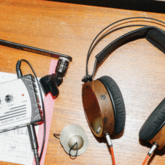Malin Bång has been described as one of the most idiosyncratic and visionary composers of her generation. Her method of composition is genuine and unpretentious, where she combines playfulness and inquisitiveness on classical instruments with sounds from various objects.
"I often use acoustic objects to explore the aural world. Physical, everyday sounds can sound fantastic, and I've written several pieces inspired by urban milieus. For example, the sound of cars on roads and heels on pavements, or the sound a traffic light makes when it changes to green," says Malin.
Her pieces are based on clear concepts and they frequently employ various forms of motion as a starting point – not only physical, human motion, but also the dynamic movement of big cities.
"Once, while standing at a train station in Tokyo, I suddenly heard the sound coming from all the wheeled-bags, and I was fascinated. I used this sound later on when I composed Structures of molten light. With that piece I tried to capture the light fluctuations of a few cities – Paris, Tokyo and Stockholm. I wanted to explore the sound of the cities' background noise during dawn and dusk.
Malin's beginnings as a composer actually came about rather naturally. When she was six years old, she told her parents that she needed a piano. By the time she had her first music lesson at the age of seven, she says she knew right away that: "Yes, this is what I want to do!"
She has maintained this course ever since – with hardly any digression. Malin knew very early on that composition was her calling. And it was no coincidence that she became a composer of art music.
"As a child, I very much enjoyed going to the opera, ballet and classical concerts. Although I listened to Carola and Herreys in primary school, and then later to Depeche Mode and Wham, it was the classical music I played which I found the most rewarding.
"In fact, I've always preferred music in a more abstract form, and I remember that when I heard Gesang der Jünglinge by Karlheinz Stockhause in secondary school, I was immediately hooked. There was something so powerful and heartbreaking – with those boys' voices – that moved me deeply."
From around the age of ten, music was essentially Malin's whole world. She attended school during the day, and spent her free time engaged in various musical pursuits. She played the piano and violin at music school, and sang in the choir.
"I've always found anything to do with music immensely fulfilling. My parents and teachers encouraged me without anyone ever having to nag me to practise."
At Hvitfeldtska Music High School in Gothenburg, Malin chose composition as an additional subject.
"There was an incredibly positive spirit at the school. I enjoyed playing both the piano and violin, but through composing I could devote myself solely and wholeheartedly to exploring the expression, phrases and dynamics of music."
After secondary school, Malin attended Härnösand College's Academy of Music where she majored in composition.
"There I discovered a whole new world of contemporary art music. I had already written my first piece of art music in secondary school, without even knowing that the term 'art music' existed. But in Härnösand, under the tutelage of composer Peter Lyne, I got to experiment with numerous composition techniques and profoundly developed my knowledge of art music."
Malin then spent four years studying composition at the Piteå School of Music, four years at the Royal College of Music, Stockholm, and a further two years at Gothenburg University's Academy of Music and Drama, punctuated by studies abroad in Berlin and Paris.
Towards the end of her studies in Stockholm, Malin, conductor Rei Munakata (also her husband), and percussionist Martin Strand formed the Curious Chamber Players ensemble. The ensemble – comprising a flautist, clarinettist, percussionist/objects, guitarist, violinist, cellist and a conductor – would soon make its mark on the European music scene.
"The ensemble has served as the artistic backbone of my work throughout the years. The other members and I have cultivated a concrete aural world wherein instruments and objects move within a spectrum of delicate and raw timbres."
Malin was commissioned for the very first time in 2003 for the Ultima Music Festival in Oslo, and work has been streaming in ever since. Today, her pieces are played all over the world, and they span everything from music for solo instruments, instrument ensembles and orchestras, to electronic music and performance pieces.
"I have thankfully never been short of work, for which I am truly grateful. My dream was to make a living as a composer and I really am living my dream."
Nowadays, Malin is also able to be selective when choosing projects. She receives more requests than she is able to accept.
"I prefer some variation and select projects accordingly, such as blending different formats and projects to produce both larger orchestral compositions and smaller percussion trios.
"I enjoy the range and contrast. Playing one day on the small, intimate stage on Sofiagatan 1 in Stockholm, which accommodates around 20 people, and then the next day playing a festival in Germany in front of a 1,000-strong audience and a large press contingent."
Many of Malin's pieces are performed in Germany and she also works a great deal in the US, Japan, Norway, Denmark, and Finland.
"The German art music scene is huge and has an extensive following. Radio still plays a huge role in Germany and there are plenty of art music festivals.
"In Sweden, art music has unfortunately become extremely marginalised. The fact is, art music is much bigger in the other Nordic countries than in Sweden. This is a political issue which I'm eager to address. One of my future projects will involve advocating for art music to receive more funding and, consequently, a more prominent stature in Sweden.
"The Swedish music scene is highly interesting and very committed, and there is a lot going on. But it needs an international context in which to grow and flourish, just like any other art form. And it really is time for politicians to start showing some pride in Swedish art music as an export."
This text was published in Stim-magasinet #2 2017
Photo credit: Elisabeth Ohlson Wallin
|
Noted works: Kudzu / the sixth phase – a musically-documented drama for ensemble Ripost – concert for percussion, double bass and symphony orchestra Avgår, pågår – for symphony orchestra Palinode – for amplified ensemble with object Irimi – for sinfonietta Kobushi Burui – for saxophone, percussion, electric guitar, piano and household appliances Purfling – for violin and electronic instruments Split Rudder – for Paetzold contrabass recorder and electronic instruments Turbid Motion – for ensemble Faces and Moon Splinters – for choir and ensemble. Distinctions and awards: Stim grants in 2003, 2005 and 2006. Grants from the Swedish Art Grants Committee in 2004, 2005, 2007 and 2008, as well as a five-year work allowance in 2010. Kranichsteiner Music Prize 2010 at Darmstadt Summer School. Residence at DAAD Artists-in-Berlin Program 2012. Recipient of the 2014 Carin Malmlöf-Forssling Composition Award. Current projects: Curious Chamber Players' new album Structures of Light and Spruce – the first consisting solely of Malin's pieces. Three composers Malin admires: Hanna Hartman, Rei Munakata and Marianthi Papalexandri-Alexandri. Malin's three favourite art music pieces: Brian Ferneyhough – Second String Quartet, Helmut Lachenmann – Schreiben, Mauricio Kagel – Exotica. In Malin's headphones right now: The Chain of the Spine by Timothy McCormack |
Age: 43
Resides: in Stockholm.
Education: composition at Härnösand College, Piteå School of Music, Berlin University of the Arts, Royal College of Music, Stockholm, Gothenburg University's Academy of Music and Drama, and a long list of courses.
STIM INFO
Joined STIM: in October 1994
Number of registered works: 96
Most radio airplay:
Turbid Motion
Alpha Waves
Perpetual Revival
Hav
Bakom, Bortom


